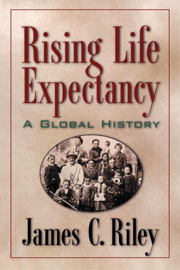Book contents
- Frontmatter
- Dedication
- Contents
- List of Figures, Maps, and Tables
- Preface and Acknowledgments
- Introduction: A Global Revolution in Life Expectancy
- 1 A Brief Overview of the Health Transition
- 2 Public Health
- 3 Medicine
- 4 Wealth, Income, and Economic Development
- 5 Famine, Malnutrition, and Diet
- 6 Households and Individuals
- 7 Literacy and Education
- Conclusion
- Index
6 - Households and Individuals
Published online by Cambridge University Press: 05 February 2015
- Frontmatter
- Dedication
- Contents
- List of Figures, Maps, and Tables
- Preface and Acknowledgments
- Introduction: A Global Revolution in Life Expectancy
- 1 A Brief Overview of the Health Transition
- 2 Public Health
- 3 Medicine
- 4 Wealth, Income, and Economic Development
- 5 Famine, Malnutrition, and Diet
- 6 Households and Individuals
- 7 Literacy and Education
- Conclusion
- Index
Summary
Neither the human environment at its most intimate, in the household, nor individual behavior seem to have allowed many opportunities for extending survival around 1800, on the eve of the health transition. In both the Indian ayurvedic and the Western humoral traditions of medicine the path to good health lay in the maintenance of a balance of humors within a person's body. Western authorities urged moderation in diet, exercise, exposure to air, bathing, and emotion, on grounds that, in extreme or violent forms, these things often led to sickness or death. In Europe good health practice required some preventive measures, such as periodically drawing blood and, by the eighteenth century, avoiding contact with decomposing organic matter. Germ theory added measures meant to avoid or defeat germs: washing hands after using the toilet, cleaning a sick room with antiseptic chemicals, pasteurizing milk, and immunizing against pathogens. In the late twentieth century risk factor theory added the idea that life-long experiences and habits may cause disease, and it revived the idea that the delayed effects of earlier life stimuli may do the same thing. Under risk factor theory, good health practice stressed the avoidance of things toxic or harmful or that might later turn out to have ill effects.
The agents of health have also changed over time. More hope has come to be vested in the value of things we can do for ourselves.
- Type
- Chapter
- Information
- Rising Life ExpectancyA Global History, pp. 169 - 199Publisher: Cambridge University PressPrint publication year: 2001



